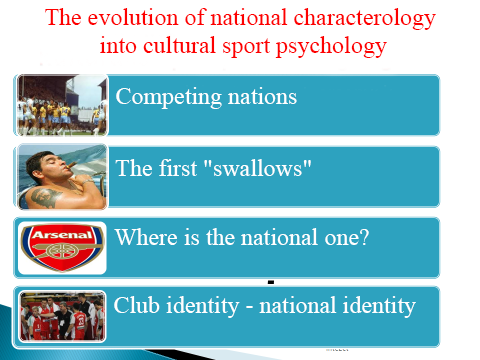Cultural differences in sport
As every field of life, sport has also undergone globalisation. In the 19th century at the time of nation states, the importance of sport grew a lot. Then in the 20th century, certain systems claimed that the superiority of their nations and systems could be proved by means of sports competitions, thus sport became a powerful tool of expressing national identities. Moreover, there have been interesting changes in sport today as well (see Fig.11).
Arsenal F. C., the English professional football club, was the first one not having any English players at all in its starting lineup. The same occurred when participating in national and international competitions as well. Although this caused quite a stir, the sporting world calmed down in the end. What is more, there are players of Turkish, Polish and African origin in the national football team of Germany, who sing the national anthem about the greatness of the German “Vaterland”. In addition to this, an American basketball player can also be found in the Hungarian national team, just like players of foreign origin (Cuban and Serbian) in the case of our national male handball team. Are these teams able to express our national identity? Are they able to strengthen the same? What kind of processes may support and prevent new athletes coming from a culture different than ours from fitting in (or their organisational socialisation in other words)? Cultural sport psychology was born to answer such questions.
Such cases are not completely new among organisations. To take an example, one might remember the conflicts arising at Hankook or Suzuki factories hitting the headlines in Hungary, during which it turned out that most of the problems occurred due to the differences between the European and Asian cultures and the ways of thinking.

Figure 11: From the beginning until today
What are the foundations of cultural psychology, sport psychology, and organisational psychology? Nothing indicates better how new these areas are than the article written by Schinke and Hanrahan (2009) [1] based on the results of the content analysis of the Journal of Sport and Exercise Psychology (including all of the issues until 1987), according to which even the most popular journal in sport psychology lacks any article or study that would approach culture as an independent variable – instead of a multicultural approach, the authors only discovered monocultural approaches in the works they studied. Not until that time did scientists and psychologists realise that culture could have been seen both as the cause and effect of something. Duda and Allison (1990) [2] claimed that the success of sport psychological support and counselling ultimately depends on the culture experts are working in as basic concepts, frameworks, the way of thinking, assumptions, values, and norms may all differ culturally.
Figure 12 below summarises what psychologists need to be aware of when working with multicultural teams or organisations.
Figure 12: Some points that experts should be aware of when improving organisational socialisation in international teams
Adopting an open attitude and the willingness to become open to anything new are the most important in this situation. Additionally, being able to communicate with people is also significant, so it might be problematic if one does not speak the language of the people he is working with. One should never be ashamed when asking for help from anyone who knows the culture they are working in to understand it better. Moreover, a great deal of patience and empathy is also required even if immediate results are expected. There are actually a lot more examples, but hopefully this brief summary will raise the awareness of sport experts and enable them to consider what was mentioned here when working with athletes of foreign origin.